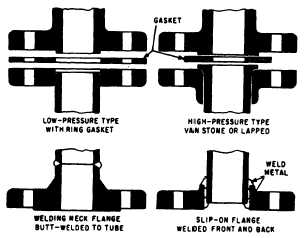Once flexible hose assemblies are installed,
there are no servicing or maintenance require-
ments other than periodic inspections. These
inspections are conducted according to mainte-
nance instruction manuals (MIMs), maintenance
requirement cards (MRCs), and depot-level
specifications.
TYPES OF FITTINGS
AND CONNECTORS
Some type of connector or fitting must be
provided to attach the lines to the components of
the system and to connect sections of line to
each other. There are many different types of
connectors and fittings provided for this purpose.
The type of connector or fitting required for a
specific system depends on several factors. One
determining factor, of course, is the type of fluid
line (pipe, tubing, or flexible hose) used in
the system. Other determining factors are the
type of fluid medium and the maximum operating
pressure of the system. Some of the most common
types of fittings and connectors are described in
the following paragraphs.
THREADED CONNECTORS
There are several different types of threaded
connectors. In the type discussed in this section,
both the connector and the end of the fluid line
(pipe) are threaded. These connectors are used in
some low-pressure fluid power systems and are
usually made of steel, copper, or brass, and are
available in a variety of designs.
Threaded connectors are made with standard
pipe threads cut on the inside surface. The end
of the pipe is threaded with outside threads.
Standard pipe threads are tapered slightly to
ensure tight connections. The amount of taper is
approximately 3/4 inch in diameter per foot of
thread.
Metal is removed when a pipe is threaded,
thinning the pipe and exposing new and rough
surfaces. Corrosion agents work more quickly at
such points than elsewhere. If pipes are assembled
with no protective compound on the threads,
corrosion sets in at once and the two sections
stick together so that the threads seize when
disassembly is attempted. The result is damaged
threads and pipes.
To prevent seizing, a suitable pipe thread
compound is sometimes applied to the threads.
The two end threads must be kept free of
5-12
compound so that it will not contaminate the
fluid. Pipe compound, when improperly applied,
may get inside the lines and components and
damage pumps and control equipment.
Another material used on pipe threads is
sealant tape. This tape, which is made of PTFE,
provides an effective means of sealing pipe
connections and eliminates the necessity of
torquing connections to excessively high values
in order to prevent pressure leaks. It also provides
for ease of maintenance whenever it is necessary
to disconnect pipe joints. The tape is applied over
the male threads, leaving the first thread exposed.
After the tape is pressed firmly against the
threads, the joint is connected.
FLANGE CONNECTORS
Bolted flange connectors (fig. 5-14) are
suitable for most pressures now in use. The
flanges are attached to the piping by welding,
brazing, tapered threads (for some low-pressure
systems), or rolling and bending into recesses.
Those illustrated are the most common types of
flange joints used. The same types of standard
fitting shapes (tee, cross, elbow, and so forth) are
manufactured for flange joints. Suitable gasket
material must be used between the flanges.
WELDED CONNECTORS
The subassemblies of some fluid power
systems are connected by welded joints, especially
in high-pressure systems which use pipe for fluid
lines. The welding is done according to standard
Figure 5-14.—Four types of bolted flange connectors.


